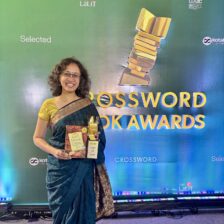
The Writers’ Club at St. Mary’s School meets only twice a week, so World Read Aloud Day sometimes becomes Writers’ Club Read Aloud Day, but so what? I celebrated it for the first time last year and it was so much fun that I did it again this year.
This time, children came forward and read work of their own, which was heart-warming. Others read out poetry, including a hilarious poem by Ruskin Bond. Still others read scenes that moved them – excerpts from Train to Pakistan, from Good Wives, and from Wonder.
Yet, as the girls came forward to read, I realised that many had no idea what to pick. One child in class IV chose an excerpt from an abridged version of King Lear. She struggled with Goneril, Regan, Cordelia and Albany. Aged nine, who wouldn’t?
Another child chose to read a section from an encyclopedia. She read fact after fact, stumbling over all the figures and words.
Why does this happen? Why do children choose to read something they find difficult?

For one, in the case of many children, one of the effects of colonisation and the value of English is that their linguistic level does not match their emotional level. This means that aged ten and eleven, they read Noddy, which they do not enjoy, but struggle to read texts that their peers are reading. Many feel that it is better to be seen struggling to read a difficult text – say King Lear – than an easy one.
Secondly, the idea of expectation. What do the adults in their lives expect them to read? Something erudite, surely. Something educational and useful, not Wimpy Kid or ‘something with too many pictures’. (I do hear adults saying that, by the way.) If that is the case, then the best choice would be to read an encyclopedia on World Read Aloud Day!
Thirdly, when children hardly read for pleasure, they honestly do not know what they can read. They look around, pick up books that they think would not be too shameful, and they read.
And that’s what leads me to the saddest thing of all – the number of children who associate reading with shame. Shame is learned behaviour, which brings me to how we pick books so that reading stays associated with pleasure rather than shame.
How do you choose a book for a child?
My first answer would be ‘Don’t’. Let the child choose. If you face a situation where a child is shamed into choosing appropriate books, here are two broad guidelines that help.
One: I PICK

P – Purpose (Why are you reading this book? To impress the teacher?)
I – Interest (Do I really like fantasy? Or do I feel I ‘ought’ to read fantasy?)
C – Comprehend (Do I understand the subject? Have I picked up a book on quantum physics because I think my teacher/parent will be wowed?)
K – Know (Do I know most of the words?)
Two: The Five-Finger Rule
When a child chooses a book, s/he could open it at random and begin to read. As s/he reads, s/he should hold up one finger for each word s/he does not know.
If there’s just one word s/he doesn’t know, the book is probably too simple.*

If there are two words s/he does not know, the book is probably still too simple.
Three words? A perfect read.
Four words on a single page that s/he does not know? Perhaps too difficult, but for a child who likes a challenge, it could work.
Five or more words? It is very likely that the child will not finish reading the book, and this is more than a little demotivating.
*This does not mean the child should not read it! I am an adult who reads picture books and chapter books where I know every word. Children, however, are often quick to judge something as kiddish, which is why a simple book may not work. If they pick the book themselves, let’s not be judgmental.
Though I remember having read these ideas before, a refresher came from the Asian Festival of Children’s Content 2017, at a session on reading conducted by Elaine Fong.
Those are just two ways that I talk about at workshops I conduct. If you have more, please do feel free to share them, or links to them, here. As I mentioned earlier, I’m trying to compile resources that we can all use.
Finally, here’s what I did for World Read Aloud Day!

Leave a Reply